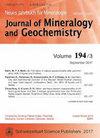Petrogenesis of an alkaline lamprophyre (camptonite) with ocean island basalt (OIB)-affinity at the NW margin of the Cuddapah basin, eastern Dharwar craton, southern India
IF 0.8
4区 地球科学
Q4 MINERALOGY
引用次数: 3
Abstract
We report petrology and geochemistry (including Sr and Nd isotopes) of a fresh lamprophyre at Ankiraopalli area at the north-western margin of Paleo-Mesoproterozoic Cuddapah basin, eastern Dharwar craton, southern India. Ankiraopalli samples possess a typical lamprophyre porphyritic-panidiomorphic texture with phenocrysts of kaersutite and diopside set in a plagioclase dominant groundmass. Combined mineralogy and geochemistry classify it as alkaline lamprophyre in general and camptonite in particular. Contrary to the calc-alkaline and/or shoshonitic orogenic nature portrayed by lamprophyres occurring towards the western margin of the Cuddapah basin, the Ankiraopalli samples display trace element composition revealing striking similarity with those of ocean island basalts, Italian alkaline lamprophyres and highlights an anorogenic character. However, the Sr-87/Sr-86(initial) (0.710316 to 0.720016) and epsilon Nd-initial (-9.54 to -9.61) of the Ankiraopalli lamprophyre show derivation from an `enriched' mantle source showing long term enrichment of incompatible trace elements and contrast from those of (i) OIB, and (ii) nearby Mahbuhnagar alkaline mafic dykes of OIB affinity. Combining results of this study and recent advances made, multiple mantle domains are identified in the Eastern Dharwar craton which generated distinct Mesoproterozoic lamprophyre varieties. These include (i) Domain I, involving sub-continental lithospheric mantle source essentially metasomatized by subduction-derived melts/fluids (represented by orogenic calcalkaline and/or shoshonitic lamprophyres at the Mudigubba, the Udiripikonda and the Kadiri); (ii) Domain II, comprising a mixed sub-continental lithospheric and asthenospheric source (represented by orogenic-anorogenic, alkaline to calc-alkaline transitional lamprophyres at the Korakkodu), and (iii) Domain III, representing a sub-continental lithospheric source with a dominant overprint of an asthenospheric (plume) component (represented by essentially alkaline lamprophyres at the Ankiraopalli). Our study highlights the varied mantle source heterogeneities and complexity of geodynamic processes involved in the Neoarchean-Paleo/Mesoproterozoic evolution of the Eastern Dharwar craton.印度南部Dharwar克拉通东部Cuddapah盆地西北缘与洋岛玄武岩(OIB)亲缘的碱性煌斑岩(camponite)的岩石成因
本文报道了印度南部Dharwar克拉通东部古-中元古代Cuddapah盆地西北缘Ankiraopalli地区一个新鲜煌斑岩的岩石学和地球化学(包括Sr和Nd同位素)。Ankiraopalli样品具有典型的煌斑岩-斑岩-泛自形结构,在斜长石为主的地块中嵌有凯尔长岩和透辉石的斑晶。结合矿物学和地球化学,将其分类为碱性煌斑岩,特别为喜树斑岩。与Cuddapah盆地西缘煌斑岩的钙碱性和(或)钾玄武岩造山性质相反,Ankiraopalli煌斑岩样品的微量元素组成与洋岛玄武岩、意大利碱性煌斑岩的微量元素组成惊人地相似,具有明显的造山特征。然而,Ankiraopalli煌斑岩的Sr-87/Sr-86(初始值)(0.710316 ~ 0.720016)和epsilon nd -初始值(-9.54 ~ -9.61)显示出源自一个长期富集不相容微量元素的“富集”地幔源,并与(i) OIB和(ii)靠近OIB亲和的Mahbuhnagar碱性基性岩脉形成对比。结合本研究成果和近期研究进展,确定了东达瓦尔克拉通的多个地幔域,形成了独特的中元古代煌斑岩品种。其中包括(i)第一领域,涉及次大陆岩石圈地幔源,主要由俯冲衍生的熔体/流体交代(以Mudigubba、Udiripikonda和Kadiri的造山钙碱性和/或shoshonic煌斑岩为代表);(ii)区域ii,包括一个混合的次大陆岩石圈和软流圈源(以造山-造山、碱性到钙碱性过渡型煌斑岩为代表,位于Korakkodu); (iii)区域iii,代表一个以软流圈(羽流)成分为主的次大陆岩石圈源(主要以Ankiraopalli的碱性煌斑岩为代表)。研究结果揭示了东达尔瓦克拉通新太古代-古/中元古代演化过程中地幔源非均质性的多样性和地球动力学过程的复杂性。
本文章由计算机程序翻译,如有差异,请以英文原文为准。
求助全文
约1分钟内获得全文
求助全文
来源期刊
CiteScore
0.90
自引率
20.00%
发文量
6
审稿时长
>12 weeks
期刊介绍:
Neues Jahrbuch für Mineralogie (Abhandlungen) publishes thorough, detailed studies of up to 30 printed pages as well as short and concise papers and notes (less than 15 printed pages) on mineralogy, i.e. crystallography, crystal chemistry, petrology, geochemistry and economic mineralogy (mineral deposits).
All fields of mineralogy: crystallography, crystal chemistry, petrology, geochemistry and economic mineralogy (mineral deposits).

 求助内容:
求助内容: 应助结果提醒方式:
应助结果提醒方式:


